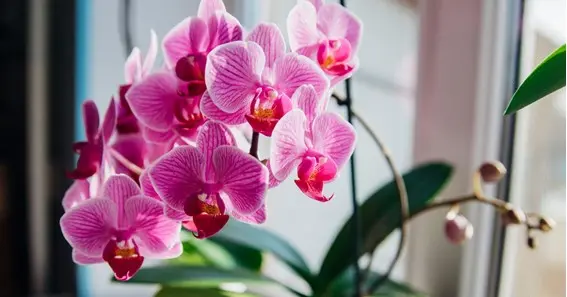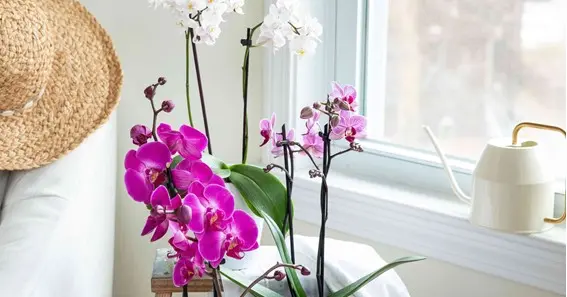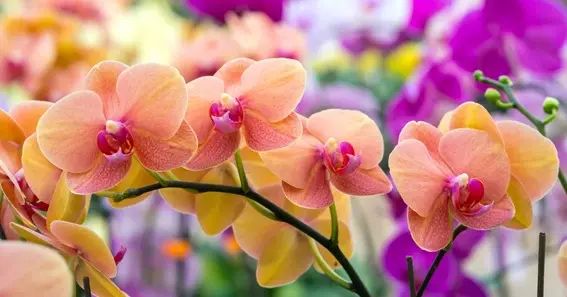How often do orchids bloom? Most orchids bloom once a year, although happy ones may blossom more. Knowing how often orchids bloom and what causes these cycles helps orchid enthusiasts care for their plants and enjoy their lovely blossoms year-round. Read on this post on how often do orchids bloom to gather more knowledge about this content.
How Often Do Orchids Bloom?
Orchids bloom at different times. Some bloom annually, while others bloom many times. The orchid’s kind, mix, growth circumstances, and care affect its blooming frequency. While moth orchids bloom once a year, their blossoms can endure for months. Combination plants like Doritaenopsis bloom more often by inheriting features from both parents.
Environmental factors, including light, weather, and humidity, affect flowering. If orchids have enough of them, they bloom more often and produce healthier blooms. Orchids’ natural growth cycle is varied, but with proper care, they can bloom more regularly.
Post-reading this post on How Often Do Orchids Bloom hope readers will have a good understanding of the topic.
What Are The Key Factors For Ensuring Orchids Bloom Successfully?

Some orchids bloom by adjusting their growth circumstances, such as temperature, to simulate seasonal changes. It would help if you examined several aspects of orchid care and the environment to understand how they bloom. Important considerations include:
Hybrids And Species Effects
Orchid varieties and hybrids bloom differently. Phalaenopsis orchids bloom once a year, whereas Cattleyas can bloom many times if conditions suit. Doritaenopsis, a hybrid of Doritis and Phalaenopsis, has summer-long blossoms. Because it combines Phalaenopsis’ larger flowers with Doritis’ extended season, knowing the qualities of your orchid species or mix helps you forecast when it will bloom and care for it.
Indirect Light To Grow
Flowers require light to grow. Most orchids appreciate robust and indirect light because it mimics their natural diffused sunlight. Not enough light can slow development, while too much direct sunshine scorches leaves. Flowers get the finest light near an east-facing window. When natural light is insufficient, faux grow lights can help plants thrive. Monitor light levels and make adjustments to ensure your orchids have enough light to flourish.
Variations In Temperature
Temperature affects orchid blooming. Chilly nights can boost blooms by making orchids like Phalaenopsis seem like autumn. Nighttime temperature drops of 10–15 degrees Fahrenheit usually cause plants to grow. Keeping daytime temperatures between 75 and 85 degrees Fahrenheit and nighttime temperatures between 60 and 65 degrees might help flowers bloom. Normal temperature variations, like those in the orchid’s natural environment, will help it bloom regularly.
Humidity Levels
Humidity between 50 and 70% is ideal for orchids. Plants grow and blossom better with enough air. Humidity trays, which place water in a box with pebbles beneath the orchid plant, or frequent misting may make an indoor room more humid. Another approach to maintaining humidity in the growth area is via a fan. To prevent plants from drying out and promote healthy growth, monitor and adjust humidity, especially in winter when indoor air can dry.
In the preceding para about how often do orchids bloom we shared some factors that affect the blooming of orchids.
How Watering Helps In Orchid Bloom?

Watering an orchid too much or too little might damage its development. Orchids should not receive water between waterings to avoid root saturation. To grow orchids regularly, you must know how much water they need. Cattleyas may require less watering than Phalaenopsis orchids once a week. Before watering again, let the growing medium dry up. Watering properly keeps roots healthy, which affects flowering.
How Nutrient Supply Helps In Growing Orchid Bloom?
Flowers require the proper nutrients at the appropriate moment to blossom. Orchids grow and bloom better when fed a balanced, high-phosphorus fertilizer. You can adjust how much fertilizer you use by feeding the plant less when it’s not growing and more when it is. The “weakly weekly” technique is common—weekly application of a mild fertilizer mix. Providing nutrition to orchids helps plants develop faster and more robustly.
Why Healthy Roots Are Essential For Orchids To Bloom?
Flowers need robust roots. Every one to two years, orchids are transplanted into a new pot to give them room to grow and clean the growth media. This maintains solid roots and regular flowering. Repotting orchids need a mix that allows airflow and water drainage. Ensuring the new container is the proper size, examining the origins, and clipping out any dead or rotten ones can help keep the flowers alive by maintaining the root system healthy.
Effect Of Environmental Changes On Orchids
Stressful factors like abrupt environmental changes, pests, and infections can prevent orchid blooming. Keeping a healthy blooming cycle requires less concern and a steady, supportive environment. Keep the growth cycle continuing by checking your orchids for pests or illnesses, such as yellowing leaves or patches, and treating any issues straight once. Maintaining the same care regimen and not changing the light, temperature, or watering helps prevent stress and encourages regular blooming.
Conclusion
In the above article on how often do orchids bloom readers must have got genuine idea about the successful blooming of orchids. Genes and environment affect orchid blooming. Knowing your orchid species or mix needs lets you create the optimal environment for regular, long-lasting blooms. If you monitor light, temperature, humidity, watering, and nutrition, your orchids will thrive and bloom. If you care for your orchids, you may enjoy their magnificent blossoms year-round, bringing class and beauty to your house.
FAQ
Do Phalaenopsis Orchids Bloom Annually?
Orchids bloom once a year, yet their blossoms endure for months. They may blossom more if you care for them and adjust the light and temperature. With ample light and a slight nighttime dip in temperature, they can grow more often.
Can My Orchid Grow Alone?
Yes, you can grow orchids by changing their environment. Place Phalaenopsis orchids somewhere colder at night to make them feel like autumn and thrive. Thermal shock moves the plant from vegetative development to bloom spikes and more blooms.
What Should I Do If My Orchid Blossoms Won’t Open?
Check plant temperature, light, humidity, and watering frequency. Orchids grow poorly under low light. Provide the plant with water and bright, indirect light. Check for pests or abrupt environmental changes that may prevent blooming in the orchid.
How Do I Care For An Orchid After Blooming?
Grown orchids typically fall dormant. Ensure the plant has enough water, light, and warmth. Apply a little fertilizer and prepare to repot the plant. This rest time helps the plant repair and prepare for development. Avoiding fertilizer and drinking less helps save the orchid energy during this period.
Why Do My Orchid Blossoms Go Off Early?
The bloom may decline too quickly due to stressors, including temperature, environment, or water shortages. Give the orchid a safe, good home and alter your care. Monitoring the plant for pests and diseases and treating them immediately helps prolong and improve blooming.
What Are Some Pointer To Guarantee That Orchid Blossoms Nicely?
Pointer for good orchid blossoms
- Proper light
- Correct Temperature
- Correct Watering
- Balance Nutrients
- Disinfect
- Pruning
Sources:
https://www.lovethatleaf.co.nz/blogs/plant-care-guides/how-to-get-orchids-to-rebloom-flower-again
https://www.repotme.com/pages/orchid-bloom-times
https://www.thespruce.com/reblooming-tips-for-phalaenopsis-orchids-1902703










